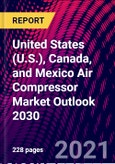An air compressor is a pneumatic device that utilizes an external power, such electric motor, diesel or gasoline engine, among others, to convert mechanical into potential energy by storing in the form of pressurized air. One of the most common functioning principle is to force more and more air into a storage tank, which thereby increases the air pressure. Once the upper engineered limit is reached, the air compressor shuts off automatically. The stored air is now ready for different end-use purposes. The air compressor market in the United States, Canada, and Mexico is anticipated to attain a CAGR of 4.90%, 3.50%, and 4.10% respectively over the forecast period, i.e., 2021 - 2030. Factors such as the growing manufacturing industry in these countries, followed by the increasing demand for energy, and the increasing demand for air compressors from the end-use industries, are some of the major factors anticipated to drive the market growth. The air compressor market in the United States, Canada, and Mexico is further estimated to generate a revenue of around USD 7960 Million, USD 830 Million, and USD 530 Million respectively by the end of 2030, up from a revenue of close to USD 4930 Million, USD 590 Million, and USD 350 Million respectively in the year 2020.
The United States (U.S.), Canada, and Mexico air compressor market is segmented by numerous segments, which include segmentation by category, product type, pressure, output power, seal type, and by end-use industry. By output power, the market is segmented into 50kW - 100kW, 100kW - 250kW, 250kW - 500kW, and above 500kW. Amongst these, in the United States, Canada, and Mexico, the 100kW - 250kW segment is expected to garner the largest revenue of about USD 3420 Million, USD 360 Million and USD 220 Million respectively by the end of 2030.
Some of the prominent industry leaders in the United States (U.S.), Canada, and Mexico air compressor market that are included in our report are Atlas Copco AB, Ingersoll Rand Inc., Sulzer Ltd., Elliott Group, Hitachi, Ltd., Sullair, LLC, Kirloskar Pneumatic Co. Ltd., Siemens AG, General Electric, Quincy Compressor LLC, Curtis-Toledo, Inc., Saylor-Beall Inc., KAESER KOMPRESSOREN, MAT Industries, LLC (Campbell Hausfeld), Sullivan-Palatek Inc., Chicago Pneumatic, Stanley Black & Decker, Inc., Werther International, Kobe Steel, Ltd., Bobcat Company, ELGi EQUIPMENTS LTD., and others.
The United States (U.S.), Canada, and Mexico air compressor market is segmented by numerous segments, which include segmentation by category, product type, pressure, output power, seal type, and by end-use industry. By output power, the market is segmented into 50kW - 100kW, 100kW - 250kW, 250kW - 500kW, and above 500kW. Amongst these, in the United States, Canada, and Mexico, the 100kW - 250kW segment is expected to garner the largest revenue of about USD 3420 Million, USD 360 Million and USD 220 Million respectively by the end of 2030.
Some of the prominent industry leaders in the United States (U.S.), Canada, and Mexico air compressor market that are included in our report are Atlas Copco AB, Ingersoll Rand Inc., Sulzer Ltd., Elliott Group, Hitachi, Ltd., Sullair, LLC, Kirloskar Pneumatic Co. Ltd., Siemens AG, General Electric, Quincy Compressor LLC, Curtis-Toledo, Inc., Saylor-Beall Inc., KAESER KOMPRESSOREN, MAT Industries, LLC (Campbell Hausfeld), Sullivan-Palatek Inc., Chicago Pneumatic, Stanley Black & Decker, Inc., Werther International, Kobe Steel, Ltd., Bobcat Company, ELGi EQUIPMENTS LTD., and others.
Table of Contents
1. Market Definition and Research Methodology
3. Market Dynamics
11. Competitive Landscape
12. Air Compressor Market Outlook
13. United States Air Compressor Market
14. Canada States Air Compressor Market
15. Mexico States Air Compressor Market
Companies Mentioned
- Atlas Copco AB
- Ingersoll Rand Inc.
- Sulzer Ltd.
- Elliott Group
- Hitachi Ltd.
- Sullair LLC
- Kirloskar Pneumatic Co. Ltd.
- Siemens AG
- General Electric
- Quincy Compressor LLC
- Curtis-Toledo Inc.
- Saylor-Beall Inc.
- KAESER KOMPRESSOREN
- MAT Industries LLC (Campbell Hausfeld)
- Sullivan-Palatek Inc.
- Chicago Pneumatic
- Stanley Black & Decker Inc.
- Werther International
- Kobe Steel Ltd.
- Bobcat Company
- ELGi EQUIPMENTS LTD.








